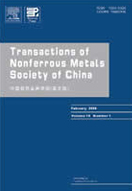Interfacial microstructure and mechanical behavior of Mg/Cu bimetal composites fabricated by compound casting process
(1. State Key Laboratory for Advanced Metals and Materials, University of Science and Technology Beijing, Beijing 100083, China;
2. State Key Laboratory of Solidification Processing, Northwestern Polytechnical University, Xi’an 710072, China)
2. State Key Laboratory of Solidification Processing, Northwestern Polytechnical University, Xi’an 710072, China)
Abstract: Mg/Cu bimetal composites were prepared by compound casting method, and the microstructure evolution, phase constitution and bonding strength at the interface were investigated. It is found that a good metallurgical bonding can be achieved at the interface of Mg and Cu, which consists of two sub-layers, i.e., layer I with 30 μm on the copper side composed of Mg2Cu matrix phase, on which a small amount of dendritic MgCu2 phase was randomly distributed; layer II with 140 μm on the magnesium side made up of the lamellar nano-eutectic network Mg2Cu+(Mg) and a small amount of detached Mg2Cu phase. The average interfacial shear strength of the bimetal composite is measured to be 13 MPa. This study provides a new fabrication process for the application of Mg/Cu bimetal composites as the hydrogen storage materials.
Key words: Mg/Cu bimetal composites; compound casting; interfacial bonding mechanism; interfacial microstructure; interfacial mechanical behavior

